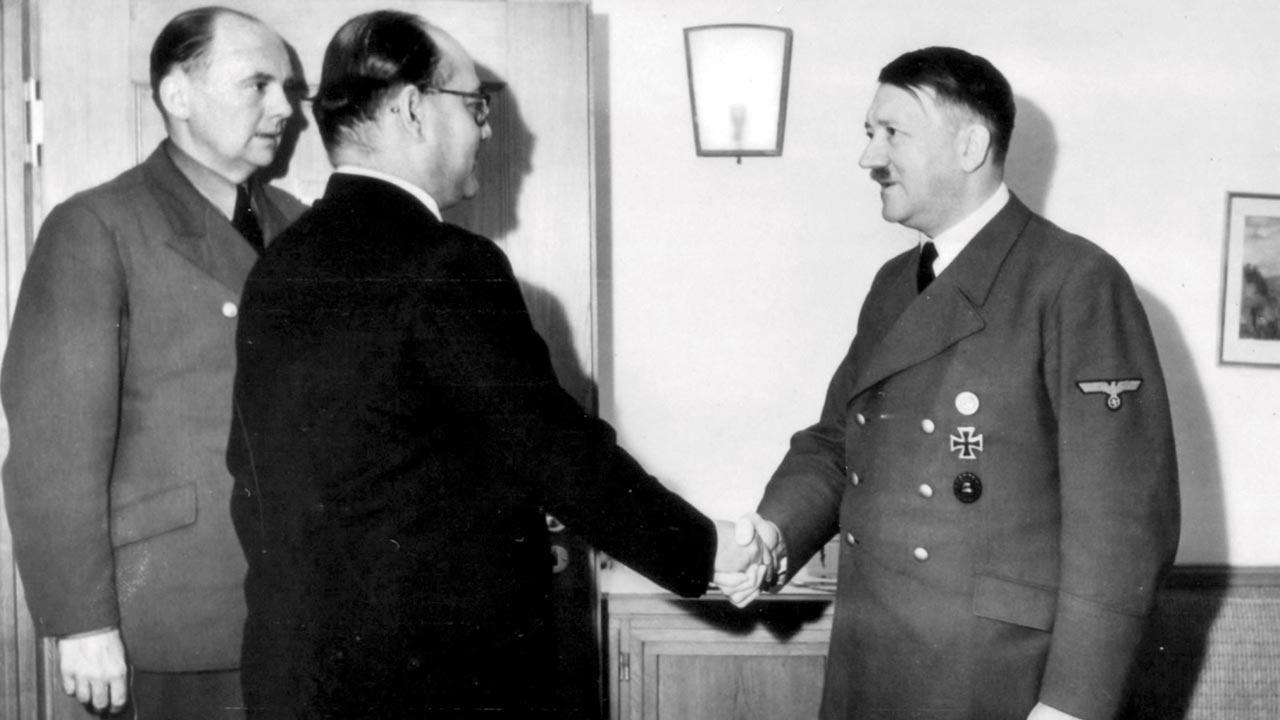Though the Nazi dictator met with Subhas Chandra Bose, and promised a submarine for his mission in the East, he was no friend of India. He thought Indians are unfit for self-rule, a new book reveals

Indian nationalist leader Subhash Chandra Bose and Adolf Hitler in Germany, 1942. Pic/Getty Images
In 2011, while reading Mein Kampf, the autobiography of Adolf Hitler, Mumbai-based journalist-author Vaibhav Purandare remembers stumbling upon a passage in the text, which had a scathing mention about India. “Did people know that the German dictator said this?” Purandare remembers asking himself. Turns out, very few did.
ADVERTISEMENT
For the next decade or so, he pored over several archives—German, Indian and British—to understand what Hitler thought about India and its struggle for freedom. “A great deal of what Hitler said or wrote about India, and all the communication he had with Indians—whether politicians, journalists, students or his own officials dealing with Indians—is not available in his published writings and speeches. Archives of the Third Reich were of critical importance to unearth all of this. So were pre-Third Reich records because, surprisingly, Hitler had articulated his views, especially about the Indian freedom movement, right from his earliest days as a speaker in Munich’s beer halls and up until his appointment as Chancellor in 1933,” Purandare shares in an email interview. He visited some of these libraries, and accessed other archival files from the 1920s to ’40s online by writing to the holders of these collections.
Vaibhav Purandare
The result is a book, Hitler and India (Westland Non-Fiction), which sheds new light on the contempt the Nazi leader felt towards Indians. His views were primarily shaped from the point of racial superiority—his assumption that everyone who wasn’t Aryan was inferior. “He didn’t need any other reasons! They’d be insignificant in his view anyway,” says Purandare, adding, “For Hitler, racial purity was everything, and everything else was secondary, and seen through this lens, the Indians fell so short, they triggered in his mind hatred. He considered them to be racially inferior and unfit. His appeasement of the British was also the result of his outlook that ‘the white race’ should rule the earth. He strongly opposed self-rule for Indians because he seriously believed they must be controlled by ‘the white race.’ That’s why he said that the Indians should consider themselves lucky they weren’t being ruled by Nazi Germany.”
In the Nazi regime, persecution and harassment of Indians living in Germany—among them Malayalee journalist ACN Nambiar, Sarojini Naidu’s son Jaya Surya Naidu, and 23-year-old student Dinanath Gopal Tendulkar—was commonplace. Many of them were branded “communist sympathisers”, and arbitrarily arrested, tortured and forcefully driven out of the country.
Yet, this dark history seems to have been conveniently forgotten, and often even overshadowed by a photograph that told a very different story. The protagonists of this photograph were Hitler and Indian nationalist leader Subhas Chandra Bose, both shaking hands and exchanging pleasant smiles. The event was a result of a near decade-long pursuit by Bose to secure a meeting with the führer.
Bose, writes Purandare, had been “acutely aware of the worrying goings-on in Germany”. In fact, just before he reached Berlin in 1933, a fresh case of atrocity had been reported against an Indian student there. But, Bose’s own attempts to reach out to Hitler came from a place of desperation. “Indians had no freedom, no lobbies, no voice on global forums, and they were in scarcely a position to assert themselves… they looked at anybody out there who could help them in their push for national liberation. And the more Germany grew stronger under Hitler, the more it appeared a possibility at least to some Indians like Bose that its energies could be diverted in the right direction.”
When the meeting finally happened, sometime between May 27 and 29 in 1942, many biographers recall it as being “awful”. “It was no doubt a disaster,” admits Purandare, who has previously authored Savarkar: The True Story of the Father of Hindutva. “It’s clear that Netaji got very little out of the meeting. Hitler had a habit of not letting other people speak during meetings. Once he started, people often found it hard to even get a word in; Stalin, interestingly, was a contrast, he’d listen quietly. In the meeting with Bose too, Hitler keeps going on and on, and out of the seven pages of the conversation recorded by Hitler’s aide, six are filled with Hitler’s ramblings.”
Despite being given very little room to speak, Bose, he says, still brought up the issue of the anti-India remarks in Mein Kampf in the meeting, requesting that Hitler clarify Germany’s attitude towards India. “I think Bose’s pursuit of the issue of Hitler’s denunciations shows his sense of integrity and his commitment to India,” he says.
What would come as a shock to many is that the Nazi leader had once also offered unsolicited advice to Lord Irwin (former Governor General and Viceroy of India), later known as Lord Halifax, to solve the “Indian problem”. “Shoot Gandhi,” he had told the visibly shocked British politician. “When Hitler spoke of shooting Gandhi, he was dead serious,” says Purandare. “For him, shooting people was a desirable and even preferred way of sorting out problems. He championed the method right through his career, ordering the killings even of some of his closest associates such as Ernst Rohm as early as 1934. For him, killings were also a way of establishing what he saw as the utopia of the Nazis. Nazi Germany proved it chillingly in the war.”
 Subscribe today by clicking the link and stay updated with the latest news!" Click here!
Subscribe today by clicking the link and stay updated with the latest news!" Click here!






